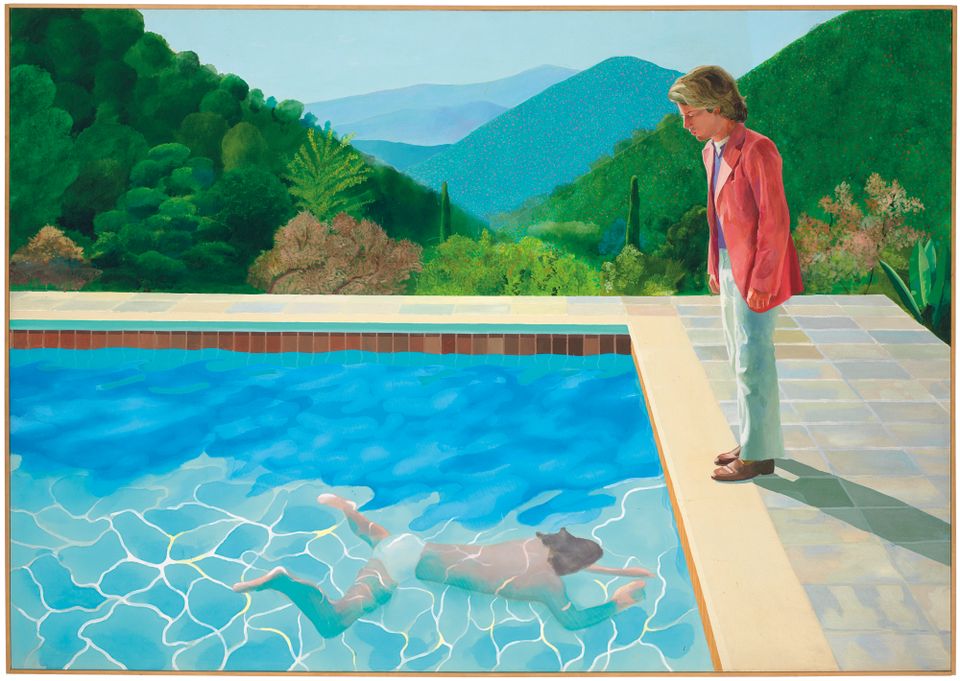One of David Hockney’s most important paintings from the 1970s is to go under the hammer at Christie’s. Portrait of an Artist (Pool with Two Figures) is a story of two compositions. The first, started in 1971, was inspired by the serendipitous juxtaposition of two photographs on the artist’s studio floor. ‘One was of a figure swimming underwater and therefore quite distorted… the other was a boy gazing at something on the ground,’ Hockney would later recall. ‘The idea of painting two figures in different styles appealed so much that I began the painting immediately.’
The initial work was ultimately destroyed by the artist after months of working and reworking — as documented in Jack Hazan’s film A Bigger Splash — but in April 1972 Hockney decided to return to the concept ahead of a planned exhibition at New York’s André Emmerich Gallery, which was due to open just four weeks later.
Armed with his Pentax camera, Hockney travelled to a villa outside Saint-Tropez, where he staged hundreds of photographs following his original composition using an assistant and friend in an idyllic pool setting.
Returning to his London studio, Hockney composed the poolside photographs, along a selection of photographs of his former lover, Peter Schlesinger wearing the same pink jacket in Kensington Gardens, across his studio wall. Taking cues from the assemblage, he worked 18 hours a days for two weeks solid, finishing the painting the night before the shippers came to transport it to New York. ‘I must admit I loved working on that picture,’ he would recall of that fortnight, ‘working with such intensity; it was marvellous doing it, really thrilling.’
Hockney’s iconic swimming pool motif also arrived by something of an accident. ‘I came to Los Angeles for two reasons,’ he said in 2009. ‘The first was a photo by Julius Shulman of Case Study House #21, and the other was AMG’s Physique Pictorial.’ The house in question is a fluid, mid-century modernist glass and steel building nestled in the Hollywood Hills, while Physique Pictorial was a male fitness publication known for homoerotic photography.
While on the final approach to Los Angeles, Hockney was struck by what he saw. ‘I looked down to see blue swimming pools all over, and I realised that a swimming pool in England would have been a luxury, whereas here they are not.’ Without realising it, he had discovered his greatest subject matter, and LA’s pools would become the setting for many of his major works of the 1960s and ’70s.
The Yorkshireman was in his mid-twenties, and the city’s private backyard swimming pools provided him with a space in which he was free to explore the male figure — in both real and pictorial terms. Painting these pools, however, initially troubled Hockney.
‘It is an interesting formal problem; it is a formal problem to represent water, to describe water, because it can be anything. It can be any colour and it has no set visual description,’ Hockney has said. ‘[The pool paintings] were about the surface of the water, the very thin film, the shimmering two-dimensionality.’
Hockney’s earliest California works from 1964 depict water as inky splashes of blue and grey, before shifting to more characteristic planes of blue broken by tangled lines. Peter Getting Out of Nick’s Pool and Sunbather, both from 1966, make use of white, yellow, pink and purple squiggles to suggest the movement of the water in a Pop-like manner, while the 1967 work A Bigger Splash contrasts a flat field of blue against white sprays of paint to indicate a recently submerged diver.
Hockney also experimented with depicting water in various media including acrylics, watercolours, crayons and lithographs, as well as his later technique of pressing dyed, wet paper pulp into sheets of paper.

